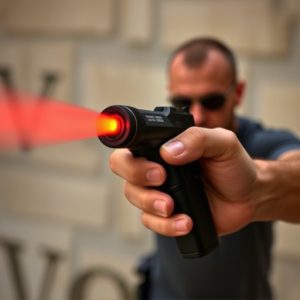Unveiling Capsaicin’s Power: A Comprehensive Guide to Pepper Spray Protection
Capsaicin, the active ingredient in pepper spray, causes intense irritation upon contact with skin a…….
Capsaicin, the active ingredient in pepper spray, causes intense irritation upon contact with skin and eyes, leading to temporary blindness and immobilization. Proper eye washing with clean water for 15 minutes is crucial to flush out capsaicin and prevent long-term damage to sensitive eye tissues. The recommended procedure, vital after any capsaicin exposure, involves keeping eyes open during irrigation to ensure thorough flushing. Side effects may include temporary blindness, difficulty breathing, and skin irritation, especially for individuals with pre-existing medical conditions; thus, consultation with a healthcare professional is advised before use.
“Discover the power of nature’s defense mechanism with our in-depth look at capsaicin-based personal protection devices. From understanding the impact of capsaicin on the human body to exploring the science behind pepper spray as a potent self-defense tool, this article covers all bases.
Learn about the key components that make up these innovative devices and gain valuable insights into effective eye washing procedures after exposure to pepper spray. Additionally, we’ll guide you through essential safety measures for responsible use, ensuring users are equipped with the knowledge to stay protected.”
- Understanding Capsaicin and Its Impact on the Human Body
- The Science Behind Pepper Spray as a Personal Defense Mechanism
- Components of a Capsaicin-Based Personal Protection Device
- Effective Eye Washing Procedure After Exposure to Pepper Spray
- Safety Measures and Precautions for Users of Capsaicin Devices
Understanding Capsaicin and Its Impact on the Human Body
Capsaicin, the active ingredient in pepper spray, is a natural compound found in chili peppers. It’s what gives them their heat and pungent flavor. When introduced to the human body, capsaicin interacts with pain receptors in the skin and eyes, triggering a sensation of burning or irritation. This reaction can immobilize an attacker temporarily, providing an opportunity for escape.
Beyond its immediate physical effects, capsaicin can also cause long-term changes in the body’s response to pain. Regular exposure desensitizes the nervous system, reducing the perception of pain over time. However, this desensitization doesn’t eliminate the compound’s irritant properties, and eye washing procedure remains crucial after any contact with pepper spray to flush out capsaicin and prevent lasting damage to sensitive eye tissues.
The Science Behind Pepper Spray as a Personal Defense Mechanism
Pepper spray, a compound derived from the capsicum plant, has gained popularity as an effective personal defense mechanism. The science behind its effectiveness lies in its active ingredient, capsaicin, which triggers a chain reaction when it comes into contact with the eyes and respiratory system. Upon exposure, capsaicin binds to pain receptors, causing a potent irritation that leads to temporary blindness and difficulty breathing. This disruption is what makes pepper spray a powerful tool for self-defense, allowing users to create distance from an attacker.
The eye washing procedure after using pepper spray is crucial to mitigate its effects. As the compound is designed to target the eyes, thorough irrigation with clean water for at least 15 minutes is recommended to flush out the irritant. This step is essential to prevent long-term damage and ensure quick recovery. Proper eye washing not only reduces discomfort but also helps individuals regain clear vision more swiftly after exposure to pepper spray.
Components of a Capsaicin-Based Personal Protection Device
A capsaicin-based personal protection device typically consists of a few key components designed to ensure its effectiveness and user safety. The primary active ingredient is capsaicin, derived from chili peppers, which is responsible for the device’s irritant properties. This compound is usually contained in a specialized cartridge or container, allowing precise delivery when needed. The device often includes a trigger mechanism, enabling users to control the release of capsaicin, whether as a spray or stream.
Accompanying the capsaicin component is an eye-washing procedure kit, a vital safety feature. This kit may include eye wash solutions and protective gear to minimize exposure during activation. Additionally, many devices come with a range of settings for different scenarios, such as a burst for close-quarters defense or a stream for longer-range deterrence, catering to various personal protection needs.
Effective Eye Washing Procedure After Exposure to Pepper Spray
After exposure to pepper spray, which contains capsaicin, immediate and proper eye washing is crucial for effective decontamination and symptom relief. The first step is to ensure the individual is in a safe location away from further exposure. Then, using clean water or a specialized eye wash solution, gently pour it over both eyes for at least 15 minutes. This helps dilute and flush out the capsaicin irritants. It’s important to keep the eyes open during the washing process to ensure thorough irrigation.
For optimal results, the eyes should be washed as quickly as possible after contact with pepper spray. If access to water is limited, over-the-counter eye wash solutions can be used as a substitute. These solutions are designed to neutralize and remove irritants, providing temporary relief from pepper spray’s effects. Remember, proper eye washing is a critical component of immediate care following exposure to capsaicin-based agents like pepper spray.
Safety Measures and Precautions for Users of Capsaicin Devices
Using a capsaicin-based personal protection device, like pepper spray, requires users to take certain safety measures and precautions. After deployment, it’s crucial to follow a specific eye washing procedure. Immediately after use, users should wash their eyes with plenty of clean, cold water for at least 15 minutes. This helps to dilute the capsaicin and alleviate irritation. It’s also important to avoid rubbing the eyes, as this can worsen the discomfort.
In addition to the eye washing procedure, users should be aware of potential side effects and risks associated with pepper spray. These may include temporary blindness, difficulty breathing, and skin irritation. Individuals with certain medical conditions, such as asthma or cardiovascular problems, should consult with a healthcare professional before using a capsaicin device. Moreover, proper storage is essential; keep the device out of reach of children and in a cool, dry place to maintain its effectiveness.
Capsaicin-based personal protection devices offer a non-lethal yet highly effective self-defense solution, leveraging the power of nature’s spicy compound. By understanding capsaicin’s impact and the science behind pepper spray, users can make informed decisions to stay safe. These devices are designed with key components to ensure potency and user safety, while proper eye washing procedures after exposure are crucial. Adhering to safety measures and precautions guarantees that individuals equipped with these tools can defend themselves effectively without causing lasting harm. Remember, knowledge is power, and being prepared for potential threats is the best defense.


